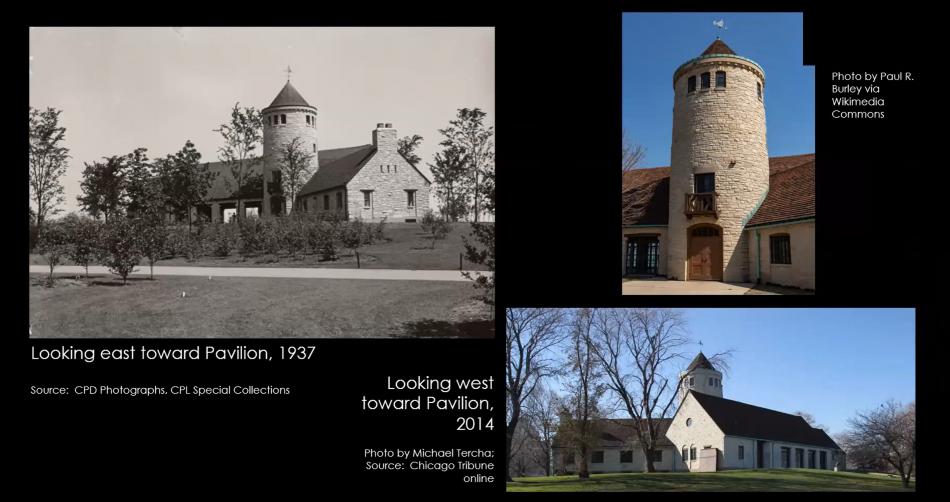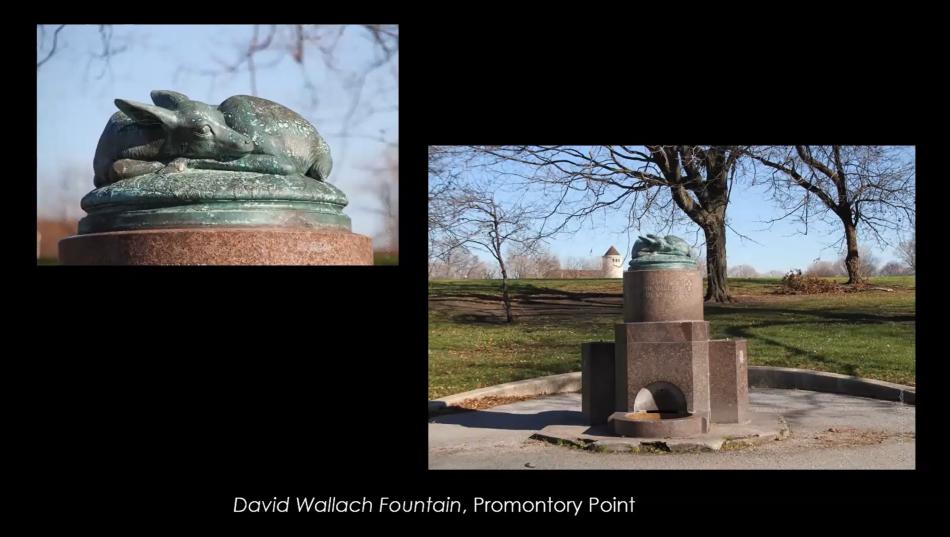The Commission on Chicago Landmarks has approved a final landmark designation for Promontory Point. Located east of Jean Baptiste Point du Sable Lake Shore Drive, the promontory sits between 54th and 56th streets in Hyde Park. Built in the 1920s and 30s, the parkland is a peninsula of artificial landfill whose landscaping was designed by Alfred Caldwell.
The curving landform is surrounded by the last remaining limestone revetments along the entire lakefront, providing views of the city and access to the lake. A circular path goes around the promontory with a large, open meadow in the center. Important features include the pavilion building designed by Emmanuel V. Buchsbaum, the David Wallach Fountain by sculptors Frederick C. Hibbard and Elizabeth Hazeltine, and four council rings designed by Caldwell.
Landmarks staff determined that Promontory Point meets four criteria for landmarking, including Criterion 1 for heritage. Built as part of Burnham’s ambitious lakefront expansion, Promontory Point was an integral part of the development of new green space in the early 20th century. To create the land, revetments were installed. The process began by driving wood piles into the lake and tying them together with steel bands. The cribs as they called them were filled in with stones and once the site behind it was infilled, cut limestone blocks were set on top of those cribs and up against the new landfill to prevent erosion. After the Great Depression, WPA funds from the New Deal helped fund the completion of Promontory Point and the construction of the pavilion building.
The next criterion is Criterion 4 for exemplary architecture. Alfred Caldwell was tapped to design Promontory Point, where he created a scene of an open meadow framed by irregular groupings of greenery that gave a sense of enclosure and framed views out towards the lake and city. This center space drastically contrasted with the limestone revetments that edged the perimeter. Emmanuel Buchsbaum, who was the Park District’s head architect, designed the pavilion building in a French Eclectic style that was uncommon for the era. The building was designed with a round tower and conical roof at the intersection of two asymmetric gabled roof wings.
The Point also meets Criterion 5 for being the work of significant architects and designers. Alfred Caldwell was a great 20th century landscape designer whose tenure included time at the Chicago Park District where he was quickly given the most ambitious and high profile projects due to his knowledge and design skills. Emmanuel V. Buchsbaum began his career as a draftsman before he spent almost his entire career at the Chicago Park District except for a few years where he worked on the State Street subway. Frederick C Hibbard and Elizabeth Hazeltine were husband and wife artists who both studied at the School of the Art Institute before working on a wide body of work that extends around the country.
The final criterion is Criterion 7 for its unique or distinct visual features. Although landfill created new green space from Grant Park to Jackson Park, Promontory Point is the only peninsula on the lakeshore. From its earliest days, Chicagoans have used it for all kinds of group outings, gatherings, and recreation.
As set forth by the landmarks staff, the designation would protect all exterior elevations and rooflines of the pavilion building, as well as the pathways, council rings, the David Wallach Fountain, and the limestone revetments. Alfred Caldwell’s landscape design of a central meadow edged by irregular groupings of plants and trees would also be included, but routine landscape maintenance would be excluded from review.
With the Chicago Park District’s Board of Directors consenting to the designation, the approval of the landmark designation was a high point for the commission, Alderman Leslie Hairston, and the community who have advocated for its conservation for decades. The proposed designation will now head to City Hall for votes from the Committee on Zoning and the full City Council. Moving forward, the designation would then require any work proposed for Promontory Point to be reviewed by landmarks staff prior to anything being done on the site.










